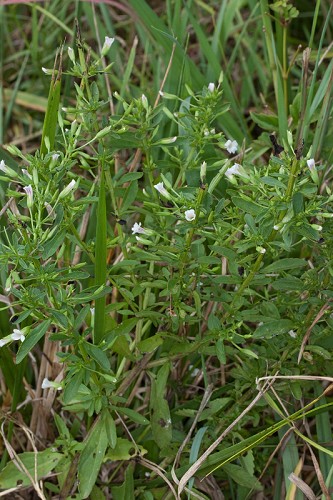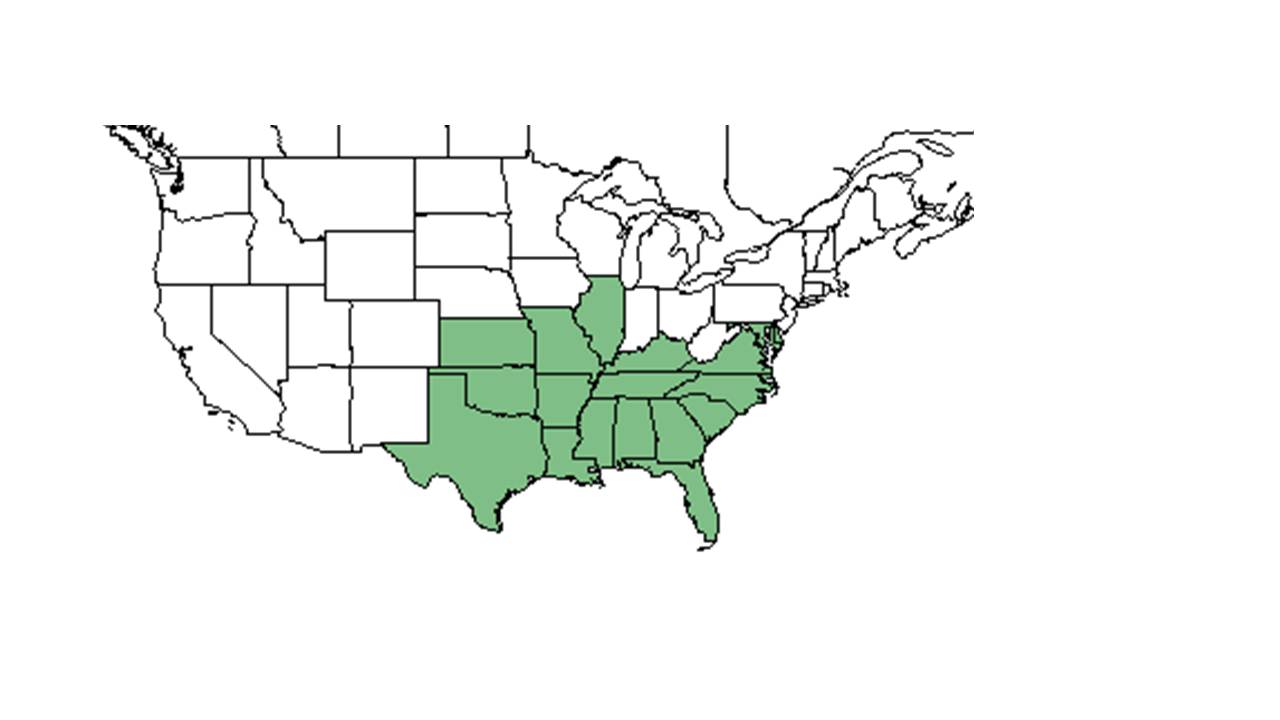Difference between revisions of "Mecardonia acuminata"
(→Ecology) |
(→Description) |
||
| (25 intermediate revisions by 11 users not shown) | |||
| Line 18: | Line 18: | ||
}} | }} | ||
| − | Common name: | + | Common name: mecardonia, common axil-flower, pond axil-flower, Florida axil-flower<ref name=weakley>Weakley, A.S. 2020. Flora of the Southeastern United States. Edition of 20 October 2020. University of North Carolina at Chapel Hill, Chapel Hill, North Carolina.</ref> |
==Taxonomic notes== | ==Taxonomic notes== | ||
| − | Synonyms: '' | + | Synonyms: ''Pagesia acuminata'' (Walter) Pennell ssp. ''typica''; ''Mecardonia acuminata'' ssp. ''acuminata''; ''Mecardonia acuminata'' ssp. ''microphyla'' (misspelling); ''Pagesia acuminata'' (Walter) Pennell ssp. ''microphylla'' (Rafinesque) Pennell; ''Mecardonia acuminata'' ssp. ''peninsularis'' (Pennell); ''Pagesia acuminata'' (Walter) Pennell ssp. ''peninsularis'' (Pennell) Pennell<ref name=weakley/> |
| + | |||
| + | Varieties: ''Mecardonia acuminata'' (Walter) Small var. ''acuminata''; ''Mecardonia acuminata'' (Walter) Small var. ''microphylla'' (Rafinesque) Pennell; ''Mecardonia acuminata'' (Walter) Small var. ''peninsularis'' Pennell<ref name=weakley/> | ||
==Description== | ==Description== | ||
<!-- Basic life history facts such as annual/perrenial, monoecious/dioecious, root morphology, seed type, etc. --> | <!-- Basic life history facts such as annual/perrenial, monoecious/dioecious, root morphology, seed type, etc. --> | ||
| − | It has been observed to be both frequent and infrequent where it is found | + | It has been observed to be both frequent and infrequent where it is found.<ref name="FSU Herbarium">Florida State University Robert K. Godfrey Herbarium database. URL: [http://herbarium.bio.fsu.edu http://herbarium.bio.fsu.edu]. Last accessed: June 2014. Collectors: Loran C. Anderson, Ann F. Johnson, Wilson Baker, Robert K. Godfrey, R.A. Norris, R. Komarek, and Lisa Keppner. States and Counties: Florida: Calhoun, Gadsden, Jackson, Jefferson, Leon, Suwannee, Taylor, and Washington. Georgia: Grady.</ref> |
| + | |||
| + | "Erect, branched, glabrous perennial, the stems angled, 1-5 dm tall, usually blackening on drying. Leaves opposite, firm, oblanceolate to elliptic, mostly 1-4.5 cm long, 5-12 mm wide, distally serrate, sessile or narrowly cuneate to a short, obscure petiole. Peduncles axillary, solitary, about as long, or longer than the subtending leaf, with 2 linear bractlets at the base; sepals 5, linear-lanceolate, 7-9 mm long; corolla white or tinged with lavender, personate, 9-11 mm long; fertile anthers 4, normal. Capsule ellipsoid, 6-8 mm long."<ref name="Radford et al 1964">Radford, Albert E., Harry E. Ahles, and C. Ritchie Bell. Manual of the Vascular Flora of the Carolinas. 1964, 1968. The University of North Carolina Press. 938. Print.</ref> | ||
| − | + | Var. ''microphylla'' is distinguished by its peduncles, which are smaller than 10 mm and its sepals, which are wider than 2 mm. Both var. ''peninsularis'' and var. ''acuminata'' exhibit the reverse of this. Var. ''peninsularis'' has main stem leaves that are 1.2-2 cm long, outer sepals that are 5-6 mm long, a corolla that is 7-9 mm long, a strongly branched base, and widely-spread branches. On the other hand, var. ''acuminata'' has main stem leaves that are 3-4.5 cm long, outer sepals that are 6-8 mm long, a corolla that is 9-10 mm long, branching that begins above the base, and a usually erect growth.<ref name=weakley/> | |
==Distribution== | ==Distribution== | ||
| + | Var. ''acuminata'' ranges from Deleware and Maryland, south to north peninsular Florida, west to east Texas, and north to Kentucky, Tennessee, and Missouri. Var. ''microphylla'' ranges from southcentral Georgia to the Florida Panhandle and west to eastern Louisiana.<ref name=weakley/> Var. ''peninsularis'' ranges from the northern Florida peninsula, south to southern Florida.<ref name=weakley/> | ||
| + | |||
==Ecology== | ==Ecology== | ||
===Habitat=== <!--Natural communities, human disturbed habitats, topography, hydrology, soils, light, fire regime requirements for removal of competition, etc.--> | ===Habitat=== <!--Natural communities, human disturbed habitats, topography, hydrology, soils, light, fire regime requirements for removal of competition, etc.--> | ||
| − | This species has been found along grassy limestone glades in open areas, in floodplain forests, and savannas | + | This species has been found along grassy limestone glades in open areas, in floodplain forests, and savannas.<ref name="FSU Herbarium"/> It also can be found in human distrubed areas such as parking areas, powerline corridors, and roadside ditches.<ref name="FSU Herbarium"/> This species grows in semi-shaded environments wet, limestone, and sandy loam soils.<ref name="FSU Herbarium"/> Var. ''acuminata'' and var. ''peninsularis'' thrive in wetland habitat types, such as marshes, ditches, wet pine savannas, bottomland forests, wet disturbed areas. Var. ''microphylla'' is limited to the margins of Coastal Plain ponds and wet pine savannas.<ref name=weakley/> In Louisiana, soils are of the upland coastal plain type with little slope and low fertility.<ref name=thi> Thill, R. E. (1983). Deer and cattle forage selection on Louisiana pine-hardwood sites. New Orleans, LA, USDA Forest Service.</ref> Associated species include ''Sporobolus vaginiflorus, Stenaria nigricans, Polygala grandiflora'' var. ''angustifolia, Rhynchospora, Fuirena,'' and ''Scleria''.<ref name="FSU Herbarium"/> |
===Phenology=== <!--Timing off flowering, fruiting, seed dispersal, and environmental triggers. Cite PanFlora website if appropriate: http://www.gilnelson.com/PanFlora/ --> | ===Phenology=== <!--Timing off flowering, fruiting, seed dispersal, and environmental triggers. Cite PanFlora website if appropriate: http://www.gilnelson.com/PanFlora/ --> | ||
| − | + | ''M. acuminata'' flowers from July through September and fruits from August through October.<ref name=weakley/> | |
| − | + | ||
| + | ===Seed dispersal=== | ||
| + | This species is thought to be dispersed by gravity.<ref>Kirkman, L. Katherine. Unpublished database of seed dispersal mode of plants found in Coastal Plain longleaf pine-grasslands of the Jones Ecological Research Center, Georgia.</ref> | ||
<!--===Seed bank and germination===--> | <!--===Seed bank and germination===--> | ||
| − | + | ===Fire ecology=== <!--Fire tolerance, fire dependence, adaptive fire responses--> | |
| + | Populations of ''Mecardonia acuminata'' have been known to persist through repeated annual burns.<ref>Platt, W.J., R. Carter, G. Nelson, W. Baker, S. Hermann, J. Kane, L. Anderson, M. Smith, K. Robertson. 2021. Unpublished species list of Wade Tract old-growth longleaf pine savanna, Thomasville, Georgia.</ref> | ||
<!--===Pollination===--> | <!--===Pollination===--> | ||
| − | <!--=== | + | <!--===Herbivory and toxicology===<--Common herbivores, granivory, insect hosting, poisonous chemicals, allelopathy, etc.--> |
<!--===Diseases and parasites===--> | <!--===Diseases and parasites===--> | ||
| − | ==Conservation and | + | ==Conservation, cultivation, and restoration== |
| − | == | + | |
| + | ==Cultural use== | ||
==Photo Gallery== | ==Photo Gallery== | ||
<gallery widths=180px> | <gallery widths=180px> | ||
| Line 49: | Line 59: | ||
==References and notes== | ==References and notes== | ||
| − | |||
| − | |||
| − | |||
| − | |||
| − | |||
Latest revision as of 19:57, 15 June 2023
| Mecardonia acuminata | |
|---|---|

| |
| Photo by John R. Gwaltney, Southeastern Flora.com | |
| Scientific classification | |
| Kingdom: | Plantae |
| Division: | Magnoliophyta - Flowering plants |
| Class: | Magnoliopsida – Dicotyledons |
| Order: | Scrophulariales |
| Family: | Scrophulariaceae |
| Genus: | Mecardonia |
| Species: | M. acuminata |
| Binomial name | |
| Mecardonia acuminata (Walter) Small | |

| |
| Natural range of Mecardonia acuminata from USDA NRCS Plants Database. | |
Common name: mecardonia, common axil-flower, pond axil-flower, Florida axil-flower[1]
Contents
Taxonomic notes
Synonyms: Pagesia acuminata (Walter) Pennell ssp. typica; Mecardonia acuminata ssp. acuminata; Mecardonia acuminata ssp. microphyla (misspelling); Pagesia acuminata (Walter) Pennell ssp. microphylla (Rafinesque) Pennell; Mecardonia acuminata ssp. peninsularis (Pennell); Pagesia acuminata (Walter) Pennell ssp. peninsularis (Pennell) Pennell[1]
Varieties: Mecardonia acuminata (Walter) Small var. acuminata; Mecardonia acuminata (Walter) Small var. microphylla (Rafinesque) Pennell; Mecardonia acuminata (Walter) Small var. peninsularis Pennell[1]
Description
It has been observed to be both frequent and infrequent where it is found.[2]
"Erect, branched, glabrous perennial, the stems angled, 1-5 dm tall, usually blackening on drying. Leaves opposite, firm, oblanceolate to elliptic, mostly 1-4.5 cm long, 5-12 mm wide, distally serrate, sessile or narrowly cuneate to a short, obscure petiole. Peduncles axillary, solitary, about as long, or longer than the subtending leaf, with 2 linear bractlets at the base; sepals 5, linear-lanceolate, 7-9 mm long; corolla white or tinged with lavender, personate, 9-11 mm long; fertile anthers 4, normal. Capsule ellipsoid, 6-8 mm long."[3]
Var. microphylla is distinguished by its peduncles, which are smaller than 10 mm and its sepals, which are wider than 2 mm. Both var. peninsularis and var. acuminata exhibit the reverse of this. Var. peninsularis has main stem leaves that are 1.2-2 cm long, outer sepals that are 5-6 mm long, a corolla that is 7-9 mm long, a strongly branched base, and widely-spread branches. On the other hand, var. acuminata has main stem leaves that are 3-4.5 cm long, outer sepals that are 6-8 mm long, a corolla that is 9-10 mm long, branching that begins above the base, and a usually erect growth.[1]
Distribution
Var. acuminata ranges from Deleware and Maryland, south to north peninsular Florida, west to east Texas, and north to Kentucky, Tennessee, and Missouri. Var. microphylla ranges from southcentral Georgia to the Florida Panhandle and west to eastern Louisiana.[1] Var. peninsularis ranges from the northern Florida peninsula, south to southern Florida.[1]
Ecology
Habitat
This species has been found along grassy limestone glades in open areas, in floodplain forests, and savannas.[2] It also can be found in human distrubed areas such as parking areas, powerline corridors, and roadside ditches.[2] This species grows in semi-shaded environments wet, limestone, and sandy loam soils.[2] Var. acuminata and var. peninsularis thrive in wetland habitat types, such as marshes, ditches, wet pine savannas, bottomland forests, wet disturbed areas. Var. microphylla is limited to the margins of Coastal Plain ponds and wet pine savannas.[1] In Louisiana, soils are of the upland coastal plain type with little slope and low fertility.[4] Associated species include Sporobolus vaginiflorus, Stenaria nigricans, Polygala grandiflora var. angustifolia, Rhynchospora, Fuirena, and Scleria.[2]
Phenology
M. acuminata flowers from July through September and fruits from August through October.[1]
Seed dispersal
This species is thought to be dispersed by gravity.[5]
Fire ecology
Populations of Mecardonia acuminata have been known to persist through repeated annual burns.[6]
Conservation, cultivation, and restoration
Cultural use
Photo Gallery
References and notes
- ↑ 1.0 1.1 1.2 1.3 1.4 1.5 1.6 1.7 Weakley, A.S. 2020. Flora of the Southeastern United States. Edition of 20 October 2020. University of North Carolina at Chapel Hill, Chapel Hill, North Carolina.
- ↑ 2.0 2.1 2.2 2.3 2.4 Florida State University Robert K. Godfrey Herbarium database. URL: http://herbarium.bio.fsu.edu. Last accessed: June 2014. Collectors: Loran C. Anderson, Ann F. Johnson, Wilson Baker, Robert K. Godfrey, R.A. Norris, R. Komarek, and Lisa Keppner. States and Counties: Florida: Calhoun, Gadsden, Jackson, Jefferson, Leon, Suwannee, Taylor, and Washington. Georgia: Grady.
- ↑ Radford, Albert E., Harry E. Ahles, and C. Ritchie Bell. Manual of the Vascular Flora of the Carolinas. 1964, 1968. The University of North Carolina Press. 938. Print.
- ↑ Thill, R. E. (1983). Deer and cattle forage selection on Louisiana pine-hardwood sites. New Orleans, LA, USDA Forest Service.
- ↑ Kirkman, L. Katherine. Unpublished database of seed dispersal mode of plants found in Coastal Plain longleaf pine-grasslands of the Jones Ecological Research Center, Georgia.
- ↑ Platt, W.J., R. Carter, G. Nelson, W. Baker, S. Hermann, J. Kane, L. Anderson, M. Smith, K. Robertson. 2021. Unpublished species list of Wade Tract old-growth longleaf pine savanna, Thomasville, Georgia.